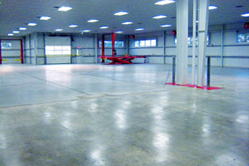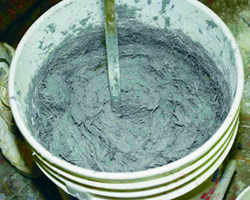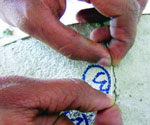Polypropylene and Polyester Fiber Reinforced Concretes
KRS.Narayan,B.E-Civil, M.Tech-Leeds Univ., FICI, FACCE
General Manager-Recron3S Business, Reliance Industries Ltd.
| Synthetic fibers are man-made fibers resulting from research and development in the petrochemical and textile industries. There are two different physical fiber forms, Monofilament fibers, and fibers produced from fibrillated tape. Currently there are two different synthetic fiber volumes used in application, namely low-volume percentage (0.1 to 0.3% by volume) and high-volume percentage (0.4 to 0.8% by volume). Most synthetic fiber applications are at the 0.1% by volume level. At this level, the strength of the concrete is considered unaffected and crack- control characteristics are achieved. |
 |
A comprehensive study was made in the laboratory with an objective of comparing the performance characteristics of concretes made with two different fibers namely, Polypropylene fibers (CTP 2024) and Polyester fibers (CT 2024), both supplied by Ms. Reliance Industries Ltd., against that of control concrete (Concrete without fibers). The dosage of fibers adopted (both Polypropylene and Polyester) for concretes with fibers were 125gms per bag of cement. The control concrete had no fibers in it. Two grades of concrete, M25 and M40 were chosen for the above study. Both fresh concrete as well as hardened concrete properties like compressive strength, flexural strength, splitting tensile strength, abrasion resistance, water permeability, RCPT, drying shrinkage and plastic shrinkage were studied on concrete specimens with and without fibers. The study indicated that at the same water/cement ratio, there was a significant reduction in the workability of concrete in terms of slump when fibers were added to it. There was a marginal improvement in parameters like compressive strength, flexural strength, splitting tensile strength, abrasion resistance, water permeability, RCPT and drying shrinkage for concretes made with fibers over that of control concrete. However, there was a significant improvement in the plastic shrinkage reduction potential of concretes incorporating fibers over that of control concrete. It was also observed that the plastic shrinkage reduction potential of concrete with polyester fibers (CT 2024) was more than that of concrete with polypropylene fibers (CTP 2024).
IntroductionSynthetic fibers are man-made fibers resulting from research and development in the petrochemical and textile industries. There are two different physical fiber forms, Monofilament fibers and fibers produced from fibrillated tape. Currently there are two different synthetic fiber volumes used in application, namely low-volume percentage (0.1 to 0.3% by volume) and high-volume percentage (0.4 to 0.8% by volume). Most synthetic fiber applications are at the 0.1% by volume level. At this level, the strength of the concrete is considered unaffected and crack-control characteristics are achieved. No elaborate study has been made prior to this study regarding the shrinkage reduction characteristics (both plastic and drying) of concretes made with low modulus synthetic fibers, particularly with reference to monofilament polyester fibers, though much emphasis has been previously given towards testing of strength properties.Scope of studyThe main scope of this studywas testing of two polymeric fibers designated by CTP2024 (Polypropylene fibers) and CT2024 (Polyester fibers). The primary objective of this study was to evaluate the performance of these two low modulus polymeric fibers when incorporated in concrete. Both fresh concrete as well as a few pre-designated hardened concrete properties were studied in comparison with a concrete made without fibers.Materials used Fibers: Polypropylene fibers designated by CTP2024; Polyester fibers designated by CT2024Coarse Aggregate: Granite, angular crushed of maximum size 20mm confirming to IS 383:1970 (Reaffirmed 2011).Fine Aggregate: Natural river sand confirming to Zone II as per the requirements of Table 4 of IS 383:1970 (Reaffirmed 2011).Water: Potable water was used for all trials.Cement: Cement used was OPC 53 Grade.Testing MethodologyMethodology adopted to conduct the above mentioned study is as follows:Two grades of concrete were chosen for conducting the study namely, M25 and M40. The cement content and w/c ratio selected for M25 grade were 330 kg/cu.m and 0.50 respectively. The cement content and w/c ratio selected for M40 grade were 410 kg/cu.m and 0.39 respectively. The concrete mix adopted for plastic shrinkage test is explained in 5.9.4.Control concrete (concrete without fibers) was used as the reference for comparing the performance of the two fibers namely CTP2024 (Polypropylene fibers) and CT2024 (Polyester fibers). The dosage of the fibers adopted for the concrete mixes with fibers was 125

|
|
Tests conducted:
The following tests were conducted on samples made from concrete without fibers (control) and with fibers (polypropylene - CTP2024 and polyester - CT2024) for two different grades of concrete (M25 and M40) except for plastic shrinkage test where a nominal specially.
|
designed mix was proposed. For hardened concrete properties, the concrete samples were cured appropriately as per IS 456 2000 (Reaffirmed 2011) before commencement of the actual tests.
a) A hollow cylindrical ring of matrix consisting of two annular rings was used for the test.
b) The diameter of the inner and outer rings was 280 mm and 580 mm respectively resulting in a concrete ring that is 150 mm wide. The height of the ring was 80 mm.
c) Twelve steel ribs were welded to the outer ring on the inner side to provide restraint (Hold the matrix to the outer ring).
d) The concrete mix was specially designed to obtain a high potential of plastic shrinkage to facilitate the study. The cement content and w/c ratio were 340 kg/cu.m and 0.55 respectively, which imparts higher water content to the mix and in turn, makes the concrete viable to plastic shrinkage. The percentage of fine aggregate used in all the mixes (with and without fibers) was 50%.
e) Concrete with and without fibers were poured into three separate ring-assemblies clearly marked and were compacted well with a smooth finish with the help of a straight edge aluminium float.
f) The initial bleeding water was carefully removed by refloating the surface after a few minutes.
g) The specimens were dried on the top using an air stream with the help of a fan at a speed of 4m/sec.
h) The temperature and humidity of the surrounding area was kept constant throughout the test.
i) The drying operation was culminated at the end of 6 hrs, by which time almost all the plastic shrinkage cracks will appear.
j) The crack areas of plain and fiber reinforced matrices were compared to evaluate the effectiveness of the fibers expressed as plastic shrinkage reduction potential.
k) Total sum of the crack areas of all the cracks gives the crack area for a particular specimen. Area of an individual crack is the product of the total length of that crack and the average width of the crack measured along its length (using a crack scope) at approximately 25 mm intervals
l) The crack area in the plain mortar matrix is taken as 100 percent and the crack area of the fiber reinforced specimens is expressed as a percentage of the plain matrix crack area.
m) The amount of crack area reduction is taken as an indicator of the effectiveness of the fibers.
Summary of Test Results
All results are based on Average values
Fresh Concrete Properties
The slump of concrete made with fibers (both polypropylene and polyester) was significantly lesser than that of control concrete, which shows that the addition of fibers had a significant effect on the workability of the concrete mixes. The addition of fibers however showed no significant difference in properties such as air content and density of fresh concrete.
|
Sl No
|
Sample
|
Grade of Concrete
|
Slump (mm)
|
Air Content (%)
|
Density (kg/m3)
|
|
1
|
Control Concrete
|
M25
|
60
|
1.8
|
2384
|
|
M40
|
50
|
1.6
|
2410
|
|
2
|
Concrete with Polypropylene Fibers
|
M25
|
25
|
1.7
|
2388
|
|
M40
|
20
|
1.6
|
2408
|
|
3
|
Concrete with Polyester Fibers
|
M25
|
25
|
1.9
|
2390
|
|
M40
|
20
|
1.5
|
2416
|
Table 1:Fresh Concrete Properities
Compressive Strength
- The 7 days compressive strength of concrete made with polypropylene fibers (CTP2024) was found to be 103.5% and 102.4%that of control concrete for M25 and M40 grades of concrete respectively.
- The 7 days compressive strength of concrete made with polyester fibers (CT2024) was found to be 102.4% and 100.8%that of control concrete for M25 and M40 grades of concrete respectively.
- The 28 days compressive strength of concrete made with polypropylene fibers (CTP2024) was found to be 101.8% and 101.0%that of control concrete for M25 and M40 grades of concrete respectively.
- The 28 days compressive strength of concrete made with polyester fibers (CT2024) was found to be 101.5% and 101.2%that of control concrete for M25 and M40 grades of concrete respectively.
Flexural Strength
- The flexural strength at 28 days of the concrete made with polypropylene fibers (CTP2024) was found to be 100.7% and 101.1%that of control concrete for M25 and M40 grades of concrete respectively.
- The flexural strength at 28 days of the concrete made with polyester fibers (CT2024) was found to be 100.5% and 100.2%that of control concrete for M25 and M40 grades of concrete respectively
Splitting Tensile Strength
- The splitting tensile strength at 28 days of the concrete made with polypropylene fibers (CTP2024) was found to be 108.5% and 104.1%that of control concrete for M25 and M40 grades of concrete respectively.
- The splitting tensile strength at 28 days of the concrete made with polyester fibers (CT2024) was found to be 105.4% and 100.8%that of control concrete for M25 and M40 grades of concreterespectively
Water Permeability Test
- The penetration of water was found to be 17mm and 13 mmfor concretes with polypropylene and polyester fibers respectively as compared to 18 mm in control concrete, for M25 grade of concrete.
- The penetration of water was found to be 4 mm and 4 mmfor concretes with polypropylene and polyester fibers respectively as compared to 6 mm in control concrete, for M40 grade of concrete.
Rapid Chloride Permeability Test (RCPT)
- The RCPT values were found to be 1834Coulombs and 1889 Coulombsfor concretes with polypropylene and polyester fibers respectively as compared to 1940Coulombs in control concrete, for M25 grade of concrete.
- The RCPT values were found to be 1198Coulombs and 1210 Coulombsfor concretes with polypropylene and polyester fibers respectively as compared to 1230Coulombsin control concrete, for M40 grade of concrete.
Abrasion Resistance of concrete
- The average loss in thickness (Wear due to abrasion) was found to be 1.55 mm and 1.60 mmfor concretes with polypropylene and polyester fibers respectively as compared to 1.63 mmin control concrete, for M25 grade of concrete.
- The average loss in thickness (Wear due to abrasion) was found to be 1.02 mm and 1.30 mmfor concretes with polypropylene and polyester fibers respectively as compared to 1.40 mmin control concrete, for M40 grade of concrete.
Plastic Shrinkage Test
 |
- The total crack area was found to be 17.55% and 3.85%for concretes with polypropylene and polyester fibers respectively when expressed as a percentage of total crack area in control concrete taken as 100%.
|
1. Conclusions
The comprehensive study indicated that at the same water/cement ratio, there was a significant reduction in the workability of concrete in terms of slump when fibers were added to it. There was a marginal improvement in parameters like compressive strength, flexural strength, splitting tensile strength, abrasion resistance, water permeability, RCPT and drying shrinkage for concretes made with fibers over that of control concrete. However, there was a significant improvement in the plastic shrinkage reduction potential of concretes incorporating fibers over that of control concrete. It was also observed that the plastic shrinkage reduction potential of concrete with polyester fibers (CT 2024) was more than that of concrete with polypropylene fibers. The test results obtained corroborate the fact that low modulus synthetic monofilament fibers can be effectively incorporated even at lower level dosages in concrete structures (Especially thin section members) more susceptible to dry weathers and other severely exposed conditions to effectively control the plastic and drying shrinkage characteristics. Though at higher dosages, they are even expected to have significant effects on flexural toughness characteristics.
2. References
- PerumalswamyN.Balaguru and SurendraP.Shah; ‘Fiber Reinforced Cement Composites’, McGraw Hill International Editions; Civil Engineering Series; 1992.
- D.J. Hannant. Fiber-reinforced concrete. Advanced Concrete Technology Set,2003, Pages 1-17. Elsevier Science Ltd .
- A. Sivakumar and Manu Santhanam. Mechanical properties of high strength concrete reinforced with metallic and non-metallic fibers. Cement and Concrete Composites,Volume 29, Issue 8,September 2007, Pages 603-608 Elsevier Science Ltd.
- Cement and Concrete Research,Volume 35, Issue 12,December 2005, Pages 2350-2359Elsevier Science Ltd
- S. Mindess and A.J. Boyd High performance fiber reinforced concrete Advances in Building Technology,2002, Pages 873-880 Elsevier Science Ltd.
Acknowledgement: The Author express his sincere thanks to the valuable contributions and advice provided by Dr.Nagendra, Director, Civil Aid-B’Lore, Shri.Raghunandan Kadaba-Principal Engineer, Civil Aid-B’Lore and Mr.Chandramouli-QC Engineer, Civil Aid-B’Lore.